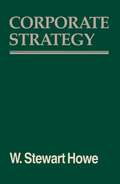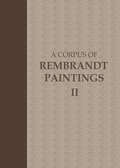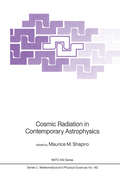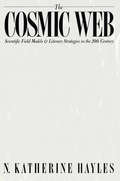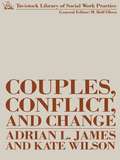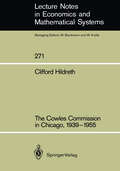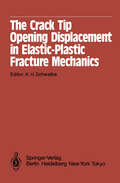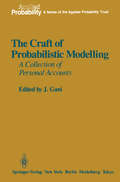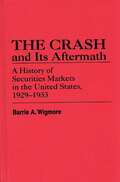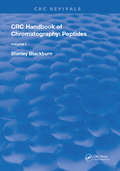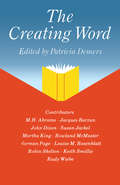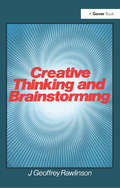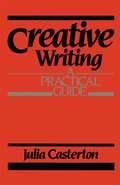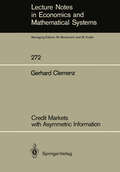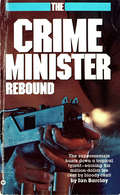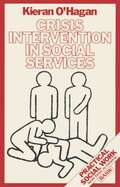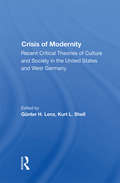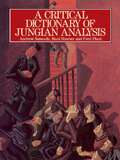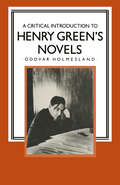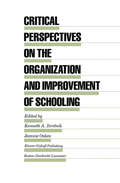- Table View
- List View
A Corpus of Rembrandt Paintings: Volume II: 1631–1634 (Rembrandt Research Project Foundation #2)
by J. Bruyn B. Haak S.H. Levie P.J.J. van ThielSince the second half of the last century art historians, realizing that the image of Rembrandt’s work had become blurred with time, have attempted to redefine the artist’s significance both as a source of inspiration to other artists and as a great artist in his own right. In order to carry on the work started by previous generations, a group of leading Dutch art historians from the university and museum world joined forces in the late 1960s in order to study afresh the paintings usually ascribed to the artist. The researchers came together in the Rembrandt Research Project which was established to provide the art world with a new standard reference work which would serve the community of art historians for the nearby and long future. They examined the originals of all works attributed to Rembrandt taking full advantage of today’s sophisticated techniques including radiography, neutron activation autoradiography, dendrochronology and paint sample analysis — thereby gaining valuable insight into the genesis and condition of the paintings. The result of this meticulous research is laid down chronologically in the following Volumes: A Corpus of Rembrandt Paintings, Volume I, which deals with works from Rembrandt’s early years in Leiden(1629-1631), published in 1982. THIS VOLUME: A Corpus of Rembrandt Paintings, Volume II, covering his first years in Amsterdam (1631-1634), published in 1986. A Corpus of Rembrandt Paintings, Volume III, goes into his later years of reputation (1635-1642), published in 1990. Each Volume consists of a number of Introductory Chapters as well as the full Catalogue of all paintings from the given time period attributed to Rembrandt. In this catalogue each painting is discussed and examined in a detailed way, comprising a descriptive, an interpretative and a documentary section. For the authenticity evaluation of the paintings three different categories are used to divide the works in: A. Paintings by Rembrandt, B. Paintings of which Rembrandt’s authorship cannot be positively either accepted or rejected, and C. Paintings of which Rembrandt’s authorship cannot be accepted. This volume (Volume II) contains 900 pages, starting of with five introductory chapters and discussing 101 paintings. In clear and accessible explanatory text all different paintings are discussed, larded with immaculate images of each painting. Details are shown where possible, as well as the results of modern day technical imaging.
Cosmic Radiation in Contemporary Astrophysics (Nato Science Series C: #162)
by M. M. ShapiroThis volume is the product of Lecturers in the fourth Course of the International School of Cosmic-Ray Astrophysics held at the Ettore Majorana Center in Erice, Sicily in November, 1984. The Course, devoted to "Cosmic Radiation in Contemporary Astrophysics," was concurrently a NATO-sponsored Advanced Study Institute (ASI). Cosmic-ray research is in a state of ferment. Precise measure ments - some made with instruments aboard sattelites and space probe- have been confronting models and theories with severe constraints. The observations of gamma-ray sources, notably Cyg X-3, at energies up to 16 10 eV, have opened up tantalizing possibilities of direct source iden tification. This ASI was devoted largely to interdisciplinary phenomena in cosmic-ray astrophysics whose understanding requires input from the other channels in astronomy. It explored the ways in which progress in cosmic-ray science might clarify phenomena observed in related disciplines. In trying to achieve this aim, we assembled a staff of lecturers representing various astrophysical specialties, such as radio astronomy, optical astronomy, X-ray astronomy, gamma-ray astronomy, and of course, particle astronomy (i.e., cosmic radiation). Students and other participants were likewise drawn from diverse backgrounds. Vigorous discussions enlivened almost every session.
The Cosmic Web: Scientific Field Models and Literary Strategies in the Twentieth Century
by N. Katherine HaylesFrom the central concept of the field—which depicts the world as a mutually interactive whole, with each part connected to every other part by an underlying field— have come models as diverse as quantum mathematics and Saussure’s theory of language. In The Cosmic Web, N. Katherine Hayles seeks to establish the scope of the field concept and to assess its importance for contemporary thought. She then explores the literary strategies that are attributable directly or indirectly to the new paradigm; among the texts at which she looks closely are Robert Pirsig’s Zen and the Art of Motorcycle Maintenance, Nabokov’s Ada, D. H. Lawrence’s early novels and essays, Borges’s fiction, and Thomas Pynchon’s Gravity’s Rainbow.
Couples, Conflict and Change: Social Work with Marital Relationships (Tavistock Library of Social Work Practice)
by Adrian JamesFirst Published in 2002. Routledge is an imprint of Taylor & Francis, an informa company.
Couples, Conflict and Change: Social Work with Marital Relationships (Tavistock Library of Social Work Practice)
by Adrian JamesFirst Published in 2002. Routledge is an imprint of Taylor & Francis, an informa company.
The Cowles Commission in Chicago, 1939–1955 (Lecture Notes in Economics and Mathematical Systems #271)
by Clifford HildrethThe author is indebted to the Alfred P. Sloan Foundation and to the Graduate School of the University of Minnesota for financial aid. This permitted visits with quite a few old Cowlespeople, reproduction of documents, and some reduction in teaching commitments. The many who responded with information and suggestions cannot be blamed for the shortcomings of the book. Faculty and staff at the Cowles Foundation were particularly helpful. Dori Clifton, Business Manager, and Karlee Gifford, Librarian, were always resourceful in locating people and documents. Michael Intrilgator, Leonid Hurwicz, and Martin Beckmann fur- Intriligator also nished perceptive comments on an earlier draft. obtained my access to the Marschak archives at UCLA. Wendy Williamson, the librarian at the Jacob C. Schmookler Library at the University of Minnesota cheerfully and efficiently handled lots of (sometimes vague) requests for reference materials and produced neat and timely drafts from very trying scratchpaper. Appropriate parts of my correspondence and some copies of documents will be placed in a Cowles Commission archive at the Cowles Foundation, Vale University.
The Crack Tip Opening Displacement in Elastic-Plastic Fracture Mechanics: Proceedings of the Workshop on the CTOD Methodology GKSS-Forschungszentrum Geesthacht, GmbH, Geesthacht, Germany, April 23–25, 1985
by K. H. SchwalbeSponsored by Studiengesellschaft zur Förderung der Kern- energieverwertung im Schiffbau und Schiffahrt e.V. (KEST), Hamburg/Stiftung Volkswagenwerk, Hannover
The Craft of Probabilistic Modelling: A Collection of Personal Accounts (Applied Probability #1)
by N.T.J. Bailey J. W. Cohen W. J. Ewens E. J. Hannan M. Iosifesu J. Keilson D. G. Kendall M. Kimura M. F. Neuts K. R. Parthasarathy N. U. Prabhu H. Solomon R. Syski L. Takacs R. L. Tweedie D. Vere-Jones G. S. Watson P. WhittleThis book brings together the personal accounts and reflections of nineteen mathematical model-builders, whose specialty is probabilistic modelling. The reader may well wonder why, apart from personal interest, one should commission and edit such a collection of articles. There are, of course, many reasons, but perhaps the three most relevant are: (i) a philosophicaJ interest in conceptual models; this is an interest shared by everyone who has ever puzzled over the relationship between thought and reality; (ii) a conviction, not unsupported by empirical evidence, that probabilistic modelling has an important contribution to make to scientific research; and finally (iii) a curiosity, historical in its nature, about the complex interplay between personal events and the development of a field of mathematical research, namely applied probability. Let me discuss each of these in turn. Philosophical Abstraction, the formation of concepts, and the construction of conceptual models present us with complex philosophical problems which date back to Democritus, Plato and Aristotle. We have all, at one time or another, wondered just how we think; are our thoughts, concepts and models of reality approxim&tions to the truth, or are they simply functional constructs helping us to master our environment? Nowhere are these problems more apparent than in mathematical model ling, where idealized concepts and constructions replace the imperfect realities for which they stand.
The Crash and Its Aftermath: A History of Securities Markets in the United States, 1929-1933 (Contributions in Economics and Economic History)
by Barrie A. WigmoreThe Crash and Its Aftermath is an excellent work of reference on the Great Contraction. It will be useful both to people with only a passing curiosity about the Crash and to those for whom the Great Depression is a major scholarly concern. Business History From now on any serious student of the Depression will be obliged to consult this work for a sense of securities price movements, investor attitudes, and relevant contemporary sources. Journal of Economic HistoryThis is the first book to focus on the broader structural changes which took place in the financial industry over the full period of decline from the Stock Market Crash in 1929 to the end of President Franklin D. Roosevelt's One Hundred Days in 1933. The basis for many of Wigmore's comments is an analysis of 142 leading companies whose stocks constituted approximately 77 percent of the market value of all New York Stock Exchange stocks. Wigmore also examines the various bond markets and relates the money market to the bond market, monetary policy, business conditions, and the problems of the banking system. Treating each year from 1929 to 1933 separately, Wigmore shows the interrelation between the stock, bond, and money markets and events in politics, the economy, international trade and finance, and monetary policy. The Statistical Appendix of 41 tables consolidates financial statistics which have hitherto been widely dispersed, permitting in-depth study.
CRC Handbook of Chromatography: Volume I: Peptides
by Ram N. GuptaThese volumes provide a reference source of different gas chromatographic, liquid chromatographic, or thin-layer chromatographic techniques for the qualitative determination of various therapeutic agents, including antibiotics, vitamins and hormones, drugs of abuse in body fluids, dosage forms, or food stuffs. Over 5000 publications were reviewed to prepare tables of chromatographic data for 800 compounds, arranged alphabetically by generic drug name or by drug groups. A detailed summary of the extraction procedure described in each publication included in the table of a particular drug is also provided. This easy-to-read handbook is useful for selecting an appropriate chromatographic procedure for the determination of a given compound according to the available facilities.
CRC Handbook of Chromatography: Volume I: Peptides
by Ram N. GuptaThese volumes provide a reference source of different gas chromatographic, liquid chromatographic, or thin-layer chromatographic techniques for the qualitative determination of various therapeutic agents, including antibiotics, vitamins and hormones, drugs of abuse in body fluids, dosage forms, or food stuffs. Over 5000 publications were reviewed to prepare tables of chromatographic data for 800 compounds, arranged alphabetically by generic drug name or by drug groups. A detailed summary of the extraction procedure described in each publication included in the table of a particular drug is also provided. This easy-to-read handbook is useful for selecting an appropriate chromatographic procedure for the determination of a given compound according to the available facilities.
The Creating Word: Papers from an International Conference on the Learning and Teaching of English in the 1980s (pdf)
by Patricia DemersCreative Thinking and Brainstorming
by J. Geoffrey RawlinsonBrainstorming is probably the best known of all the techniques available for creative problem solving. This book, by one of the world’s foremost exponents of brainstorming, begins by identifying the barriers to creative thinking and showing how they can be removed. It goes on to set out systematic procedures for organizing effective brainstorming sessions, for evaluating the ideas produced, and for introducing the brainstorming approach into an organization. This is a highly practical book, illustrated throughout by examples drawn from the author's experience with nearly eight hundred groups of managers in four continents.
Creative Thinking and Brainstorming
by J. Geoffrey RawlinsonBrainstorming is probably the best known of all the techniques available for creative problem solving. This book, by one of the world’s foremost exponents of brainstorming, begins by identifying the barriers to creative thinking and showing how they can be removed. It goes on to set out systematic procedures for organizing effective brainstorming sessions, for evaluating the ideas produced, and for introducing the brainstorming approach into an organization. This is a highly practical book, illustrated throughout by examples drawn from the author's experience with nearly eight hundred groups of managers in four continents.
Credit Markets with Asymmetric Information (Lecture Notes in Economics and Mathematical Systems #272)
by Gerhard ClemenzCrime Minister: Rebound - Book #3 (Crime Minister #3)
by Ian BarclayIt's a mission-dollar job for Richard Dartley, the world's most select assassin-for-hire, the man with many aliases and a thousand ways to kill. For him, the fatal hit should be a simple matter of clear planning and clean execution. But amid the shifting loyalties and tangled intrigue on American's newest and hottest battleground , he knows damn well things are a lot more dangerous than they seem...
Crisis Intervention in Social Services (Practical Social Work Series)
by Kieran O'Hagan... this book could only have been written by a social worker. It is full of energy, laced with pathos and humour, and the warts are not only visible but highlighted. It offers a thoughtful, down-to-earth view of crisis work in one social services team.' Paul Reading, Oxford MIND
The Crisis Of Modernity: Recent Critical Theories Of Culture And Society In The United States And West Germany
by Gunter H. Lenz Kurt L. ShellThe crisis~ of the "project of modernity" (Habermas) is, at the same time, a crisis of critical theories of society and culture that have radically questioned bourgeois culture and capitalist society and economy from the perspective of a utopia of enlightened rationality. A number of parallel recent social and political problems, developments, and
The Crisis Of Modernity: Recent Critical Theories Of Culture And Society In The United States And West Germany
by Gunter H. Lenz Kurt L. ShellThe crisis~ of the "project of modernity" (Habermas) is, at the same time, a crisis of critical theories of society and culture that have radically questioned bourgeois culture and capitalist society and economy from the perspective of a utopia of enlightened rationality. A number of parallel recent social and political problems, developments, and
A Critical Dictionary of Jungian Analysis
by Andrew Samuels Bani Shorter Fred PlautThe language of Jung's writings, and of analytical psychology generally, is sometimes difficult to understand. This guide, in dictionary format, combines scholarship and historical accuracy with a stimulating, critical attitude.
A Critical Dictionary of Jungian Analysis
by Andrew Samuels Bani Shorter Fred PlautThe language of Jung's writings, and of analytical psychology generally, is sometimes difficult to understand. This guide, in dictionary format, combines scholarship and historical accuracy with a stimulating, critical attitude.
A Critical Introduction to Henry Green’s Novels: The Living Vision (pdf) (Studies in 20th Century Literature)
by Oddvar HolmeslandCritical Perspectives on the Organization and Improvement of Schooling (Evaluation in Education and Human Services #13)
by Jeannie Oakes Kenneth A. SirotnikMajor "paradigm shifts"-replacing one "world view" with another regarding what constitutes appropriate knowledge do not happen over night. Centuries usually intervene in the process. Even minor shifts admitting alternative world views into the domain of legitimate knowledge producing theory and practice-require decades of controversy, especially, it seems to us, in the field of education. It has only been in the last 20 years or so that the educational research community has begun to accept the "scientific" credibility of the qualitative approaches to inquiry such as participant observation, case study, ethnogra phy, and the like. In fact, these methods, with their long and distinguished philosophical traditions in phenomenology, have really only come into their own within the last decade. The critical perspective on generating and evaluating knowledge and practice-what this book is mostly about-is in many ways a radical depar ture from both the more traditional quantitative and qualitative perspec tives. The traditional approaches, in fact, are far more similar to one another than they are to the critical perspective. This is the case, in our view, for one crucial reason: Both the more quantitative, empirical-analytic and qualitative, interpretive traditions share a fundamental epistemological commitment: they both eschew ideology and human interests as explicit components in their paradigms of inquiry. Ideology and human interests, however, are the "bread and butter" of a critical approach to inquiry.
